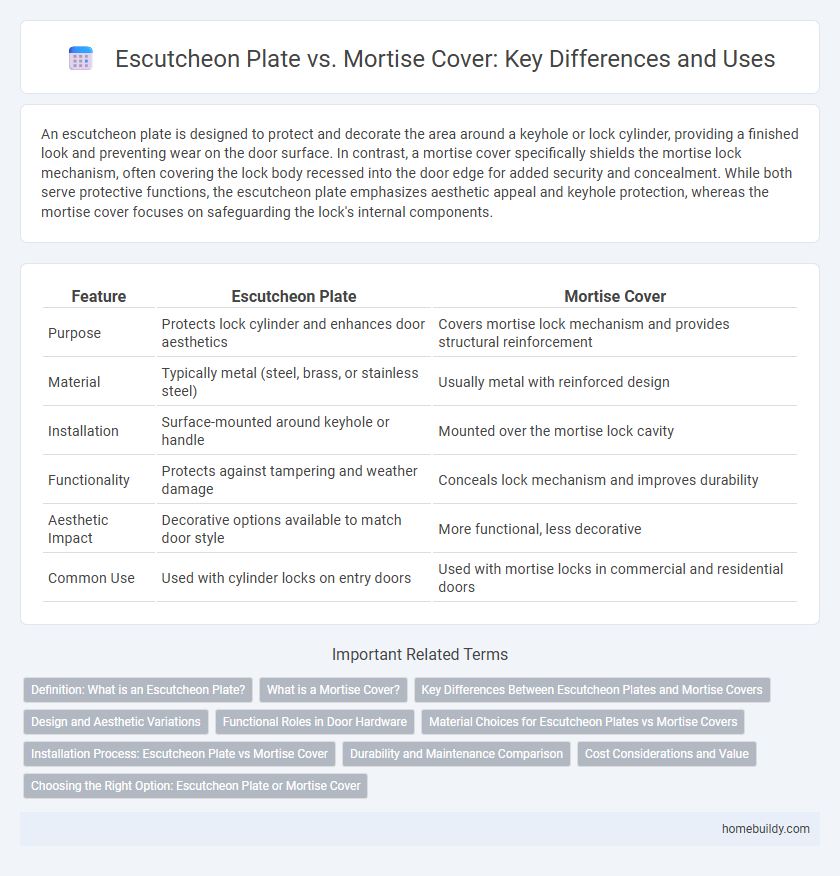An escutcheon plate is designed to protect and decorate the area around a keyhole or lock cylinder, providing a finished look and preventing wear on the door surface. In contrast, a mortise cover specifically shields the mortise lock mechanism, often covering the lock body recessed into the door edge for added security and concealment. While both serve protective functions, the escutcheon plate emphasizes aesthetic appeal and keyhole protection, whereas the mortise cover focuses on safeguarding the lock's internal components.
Table of Comparison
| Feature | Escutcheon Plate | Mortise Cover |
|---|---|---|
| Purpose | Protects lock cylinder and enhances door aesthetics | Covers mortise lock mechanism and provides structural reinforcement |
| Material | Typically metal (steel, brass, or stainless steel) | Usually metal with reinforced design |
| Installation | Surface-mounted around keyhole or handle | Mounted over the mortise lock cavity |
| Functionality | Protects against tampering and weather damage | Conceals lock mechanism and improves durability |
| Aesthetic Impact | Decorative options available to match door style | More functional, less decorative |
| Common Use | Used with cylinder locks on entry doors | Used with mortise locks in commercial and residential doors |
Definition: What is an Escutcheon Plate?
An escutcheon plate is a protective or decorative metal plate that surrounds a keyhole or door handle, designed to enhance the appearance and provide a barrier against wear and tampering. It differs from a mortise cover, which specifically conceals the mortise lock mechanism within a door, offering a more substantial protective function. Escutcheon plates are often used in residential and commercial doors to combine functionality with aesthetic appeal.
What is a Mortise Cover?
A mortise cover is a metal plate designed to conceal and protect the mortise lock mechanism installed within a door. Unlike an escutcheon plate that surrounds the keyhole or thumb turn, a mortise cover specifically guards the lock case and lockset components, preventing tampering and wear. Mortise covers are essential for enhancing door security and maintaining a clean, seamless appearance where the lock is mortised into the door edge.
Key Differences Between Escutcheon Plates and Mortise Covers
Escutcheon plates serve primarily as decorative keyhole covers that protect door hardware while enhancing aesthetic appeal, often mounted flush against door surfaces. Mortise covers specifically protect mortise lock mechanisms by covering the lock cavity, providing structural shielding and durability against wear and tampering. The key difference lies in their function and placement: escutcheon plates emphasize visual finishing and keyhole protection while mortise covers focus on safeguarding the lock mechanism within the door.
Design and Aesthetic Variations
Escutcheon plates offer sleek, minimalist designs that enhance modern door hardware aesthetics, often featuring smooth surfaces and subtle contours to complement contemporary interiors. Mortise covers typically present more elaborate, decorative patterns reflecting traditional or vintage styles, with intricate engravings or raised motifs that add historical character. Choosing between these elements depends on whether the design goal prioritizes streamlined elegance or ornate detail, impacting the overall visual harmony of the door assembly.
Functional Roles in Door Hardware
Escutcheon plates provide a protective and decorative cover around keyholes or lock cylinders, enhancing security by preventing tampering and wear on the door surface. Mortise covers specifically shield the mortise lock mechanism, concealing the lock pocket and facilitating easier replacement or maintenance. Both components contribute to door hardware functionality by securing the lock area, but escutcheon plates prioritize aesthetic integration and user interface, while mortise covers emphasize mechanical protection and access.
Material Choices for Escutcheon Plates vs Mortise Covers
Escutcheon plates are predominantly crafted from materials like stainless steel, brass, or zinc alloy, offering durability and corrosion resistance suitable for both interior and exterior doors. Mortise covers typically utilize heavier gauge metals such as solid brass or steel to provide enhanced protection and support for the mortise lock mechanism. The choice of material directly impacts the longevity and aesthetic compatibility of escutcheon plates versus mortise covers in various architectural applications.
Installation Process: Escutcheon Plate vs Mortise Cover
The installation process of an escutcheon plate involves simple surface mounting with screws, making it quick and straightforward for door hardware. In contrast, a mortise cover requires precise fitting into a recessed pocket within the door, demanding more skill and time to ensure proper alignment and secure attachment. Escutcheon plates are ideal for surface-mounted locks, while mortise covers are specifically designed for mortise lock installations, reflecting their differing installation complexities.
Durability and Maintenance Comparison
Escutcheon plates are typically made from solid metals such as brass or stainless steel, offering superior durability compared to mortise covers, which often use thinner materials prone to bending or corrosion over time. Maintenance of escutcheon plates is minimal due to their robust finish and resistance to wear, while mortise covers may require more frequent cleaning and replacement to prevent rust and maintain appearance. Their sturdy construction ensures longer lifespan and less frequent upkeep, making escutcheon plates a preferred choice for high-traffic or outdoor door applications.
Cost Considerations and Value
Escutcheon plates generally offer a lower cost option compared to mortise covers due to simpler manufacturing processes and less material usage. Mortise covers provide enhanced durability and protection, often justifying their higher price with increased longevity and security benefits. Choosing between the two depends on budget constraints and the desired balance of upfront cost versus long-term value.
Choosing the Right Option: Escutcheon Plate or Mortise Cover
Escutcheon plates provide a decorative and protective solution by covering the keyhole and surrounding area, enhancing both aesthetics and security on door surfaces. Mortise covers, designed specifically to conceal mortise lock bodies, offer a robust shield against tampering while maintaining a flush, low-profile appearance. Selecting between an escutcheon plate and a mortise cover depends on the door hardware type, desired security level, and architectural style, ensuring optimal functionality and design harmony.
Escutcheon plate vs Mortise cover Infographic

 homebuildy.com
homebuildy.com